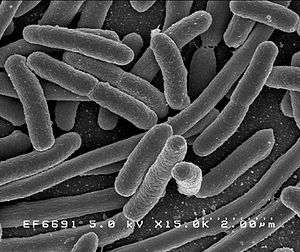Gracilicutes
Gracilicutes (Latin: gracilis, slender, and cutis, skin, referring to the cell wall) is a clade in bacterial phylogeny.[2]
| Gracilicutes | |
|---|---|
 | |
| Escherichia coli cells magnified 25,000 times | |
| Scientific classification | |
| Domain: | Bacteria |
| (unranked): | Gracilicutes Gibbons and Murray 1978[1] |
| Superphyla/Phyla | |
Traditionally gram staining results were most commonly used as a classification tool, consequently until the advent of molecular phylogeny, the Kingdom Monera (as the domains Bacteria and Archaea were known then) was divided into four phyla,[3][4]
- Gracilicutes (gram-negative, it is split in many groups, but some authors still use it in a narrower sense)
- Firmacutes [sic] (gram-positive, subsequently corrected to Firmicutes,[5] today it excludes the Actinobacteria)
- Mollicutes (gram variable, posteriorly renamed as Tenericutes, e.g. Mycoplasma)
- Mendosicutes (uneven gram stain, "methanogenic bacteria" now known as methanogens and classed as Archaea)
This classification system was abandoned in favour of the three-domain system based on molecular phylogeny started by C. Woese.[6][7]
This taxon was revived in 2006 by Cavalier-Smith as an infrakindgom containing the phyla Spirochaetae, Sphingobacteria (FCB), Planctobacteria (PVC), and Proteobacteria.[8] It is a gram-negative clade that branched off from other bacteria just before the evolutionary loss of the outer membrane or capsule, and just after the evolution of flagella.[8] This taxon is not generally accepted and the three-domain system is followed.[9]
An almost identical taxon called Hydrobacteria was defined in 2009 using bioinfomatic methods. It is in contrast to the other major group of eubacteria called Terrabacteria. The analysis also altered the internal phylogeny of this group, with PVC-FCB-Spirochaetae placed forming a clade next to Proteobacteria. What was PVC is described as polyphyletic.[10]
Relationships
The following graph shows Cavalier-Smith's version of the tree of life, indicating the status of Gracilicutes.
|
Legend: | |||||||||||||||||||||||||||||||||||||||||||||||||||||||||||||||||||||
|
References
- Gibbons, N. E. & Murray, R. G. E. 1978. Proposals concerning the higher taxa of bacteria. Int J Syst Bacteriol 28:1–6, (PDF)
- Bastien Boussau et al 2008. "Accounting for horizontal gene transfers explains conflicting hypotheses regarding the position of aquificales in the phylogeny of Bacteria." Phylogenetic tree obtained from 56 genes of Bacteria. BMC Evolutionary Biology 2008, 8:272 doi:10.1186/1471-2148-8-272
- Gibbons, N.E. & Murray, R.G.E. (1978). Proposals concerning the higher taxa of bacteria. International Journal of Systematic Bacteriology, 28, 1-6, .
- Krieg, N.R. & Holt, J.C. (eds., 1984). Bergey’s Manual of Systematic Bacteriology, 1st ed., vol. 1, Williams and Wilkins, Baltimore, .
- Murray, R.G.E. (1984). The higher taxa, or, a place for everything...?. In: N.R. Krieg & J.G. Holt (ed.) Bergey's Manual of Systematic Bacteriology, vol. 1, The Williams & Wilkins Co., Baltimore, p. 31-34
- Woese, C. R. (1987). "Bacterial evolution". Microbiological Reviews. 51 (2): 221–271. PMC 373105. PMID 2439888.
- Don J. Brenner; Noel R. Krieg; James T. Staley (July 26, 2005) [1984(Williams & Wilkins)]. George M. Garrity (ed.). Introductory Essays. Bergey's Manual of Systematic Bacteriology. 2A (2nd ed.). New York: Springer. p. 304. ISBN 978-0-387-24143-2. British Library no. GBA561951.
- Cavalier-Smith T (2006). "Rooting the tree of life by transition analyses". Biol. Direct. 1: 19. doi:10.1186/1745-6150-1-19. PMC 1586193. PMID 16834776.
- Krieg, N.R.; Ludwig, W.; Whitman, W.B.; Hedlund, B.P.; Paster, B.J.; Staley, J.T.; Ward, N.; Brown, D.; Parte, A. (November 24, 2010) [1984(Williams & Wilkins)]. George M. Garrity (ed.). The Bacteroidetes, Spirochaetes, Tenericutes (Mollicutes), Acidobacteria, Fibrobacteres, Fusobacteria, Dictyoglomi, Gemmatimonadetes, Lentisphaerae, Verrucomicrobia, Chlamydiae, and Planctomycetes. Bergey's Manual of Systematic Bacteriology. 4 (2nd ed.). New York: Springer. p. 908. ISBN 978-0-387-95042-6. British Library no. GBA561951.
- Battistuzzi, F. U.; Hedges, S. B. (6 November 2008). "A Major Clade of Prokaryotes with Ancient Adaptations to Life on Land". Molecular Biology and Evolution. 26 (2): 335–343. doi:10.1093/molbev/msn247.